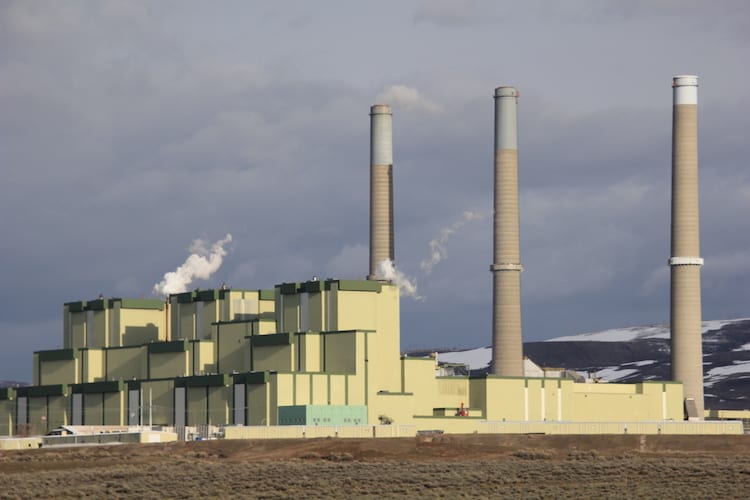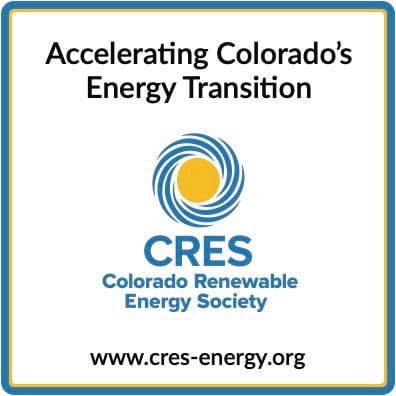PUC commissioners say OK to 307-megawatt gas plant at Craig as Tri-State prepares to close its coal units there.
by Allen Best
The Colorado Public Utilities Commission has said yes to a 307-megawatt natural gas plant at Craig that Tri-State Generation and Transmission wants to build as it prepares to close its coal-burning units there.
What does this say, if anything, about how the PUC may rule in a vaguely parallel case involving Xcel Energy? Xcel also wants to add natural gas as it closes coal plants and gears up for projected growth in demand.
The easy answer is that the PUC tends to accept the assertions of the electrical utilities that they need natural gas. Most of the larger electrical utilities in Colorado have plans to build natural gas.
One of them, Brighton-based United Power, began getting power this summer from a new 162-megawatt natural gas plant called Mountain Peak Power. United Power is not regulated by the PUC and hence needed no permission. United says it will use the plant with moderation, as needed to satisfy peak demands, particularly during summer months. Tri-State also has said it will use its new gas plant somewhat sparingly. Unlike the coal plants, it will not be to provide baseload generation.
Colorado Springs Utilities and Platte River Power Authority also have plans for new natural gas plants, and neither is regulated by the PUC.

United Power is now getting electricity from the six new gas-fired turbines at Mountain Peak Power south of Keenesburg. Photo/Allen Best
In their comments at their Aug. 1 meeting, the commissioners also expressed some skepticism that Tri-State had fully made the case for the gas plant.
At issue is whether electrical utilities truly need all the additional gas generation they say they need. At least some in the environmental camp contend that this push for natural gas echoes the debate 20 years ago when both Xcel and Tri-Sate were pushing to build new coal plants.
In 2004, Xcel gained PUC permission to build a new coal-burning unit at Pueblo called Comanche 3. It was to operate until 2070. Now, it is scheduled to close by New Year’s Eve of 2030 but will ramp down operations to seasonal use even before then. It was, and is, the largest coal-burning unit ever constructed in Colorado. The plant along the Arkansas River has a capacity of 750 megawatts.
At the same time Xcel was getting its approval from the PUC, Tri-State was starting to ramp up its plans to build an even larger coal plant 200 miles downriver along the Arkansas River in western Kansas.
The 895-megawatt plant (originally proposed for 1,400 megawatts) did not need approval from the Colorado PUC but it did need approval from Kansas. Instead, it got a rejection in 2007. In 2017, Tri-State did get approval from Kansas, but by then, it was clear that the coal era was ending as cost of both wind and solar had rapidly tumbled and utilities had learned how to deal with the intermittencies of renewables. Tri-State ended up spending upwards of $90 million and possibly more than $100 million.
Tri-State is a very different utility now. It has long moved past its nearly singular embrace of coal abetted by natural gas plants. Duane Highley, then-new chief executive, announced in early 2019 that Tri-State would close its coal units at Craig as part of its pivot to renewable generation. The last unit is to close by the end of 2027. Tri-State is on a path of reducing carbon emissions from its electrical 80% by 2030 as compared to a 2005 baseline, in accordance with Colorado’s goals.
This electric resource plan before the PUC will assist in that decarbonization. It includes:
- Two 200-megawatt wind farms, one in eastern Colorado and one in either Wyoming or western Nebraska.
- Two solar projects, one with 200 megawatts capacity in eastern Colorado. The second, to be in New Mexico, is to have 100 megawatts capacity and also battery storage.
- Five battery storage projects across both eastern and western Colorado totaling 600 megawatts.
Helping finance these projects will be $679 million in grants and low-interest loans that Tri-State has received from the U.S. Department of Agriculture’s New ERA (Empowering Rural America) program, which is part of the Inflation Reduction Act. The funding had been promised before the Trump administration began efforts to pull back support of renewable generation.
The chief issue before the PUC on Aug. 1 was whether to approve the new gas plant, as Tri-State wanted.
The utility had also identified an alternative proposal that would have included a small increase in generating capacity at an existing plant near Fort Lupton. That alternative, however, also called for a far larger investment in lithium-ion batteries.
The decision fundamentally hinged on Tri-State’s discomfort with planning a future without new fossil fuels. It has several existing natural gas plants in Colorado and will continue to have access to generation from a coal plant in Wyoming and, until 2031, a plant in Arizona.
Tri-State said it had no experience with batteries on a large scale and was uncomfortable with the “potential risk in over-reliance on 4-hour batteries,”
For a time, Tri-State had resisted battery storage. It objected in 2018 when one of its then members, United Power, set up a four-megawatt-hour Tesla battery behind one of its offices along Interstate 25 between Firestone and Longmont. It was, at the time and then for several more years, the largest battery in Colorado.
Another decision point was the calculation of costs. Tri-State delivered estimates that showed that the natural gas plant was the less-costly alternative. Some in the environmental camp produced figures showing that the battery-heavy alternative as less costly. If the social cost of carbon and methane were part of the equation, the batteries would have definitely won. However, those costs alone under Colorado law are not decisive in making resource decisions.
The just transition component added yet another layer of complexity, a point raised by Eric Blank, the commission chair (and a former wind and solar developer).
A settlement agreement reached in July 2024 among various parties, including several environmental groups and the Office of Utility Consumer Advocate, had agreed to an openness to consider a natural gas plant as part of the just transition for Craig and Moffat County. Colorado legislators, when adopting decarbonization goals in 2019, had also said they wanted to provide a just transition for Craig and other coal-dependent communities. This new gas plant will result in “slightly higher emissions” but this can be addressed with units after 2030, said the Office of Utility Consumer Advocate in its May testimony.
This gas plant won’t directly replace the tax base and loss of relatively high-paying jobs in Craig, but it will help.
And finally, as was noted by Commissioner Megan Gilman, there is a time element in getting new generation, given both supply chain challenges and the shifted federal landscape for wind and solar generation created by the Big Beautiful Budget Bill passed by Congress in early July.
While all three PUC commissioners voted for the gas plant alternative, the most robust support came from Blank, who said the choice of the gas plant was “reasonable and supported by evidence on this record.”
Blank noted that this will help Moffat County in its efforts to adjust economically to the loss of tax base and well-paying jobs. And Tri-State would still meet its reduced emissions goals.
Gilman and Tom Plant, the third commissioner, supported the gas plant but with reservations. Gilman described “some really legitimate concerns with some of the information” provided by Tri-State. That left the commissioners to make a decision without a clear record. She reported seeing “more nuance” to how least cost was calculated than did Tri-State. With gas, renewables will be curtailed. Plus, there is a cost of emissions to the atmosphere.
“I’m not sure the least-cost determination as claimed is as cut and dry” as was found by Tri-State,” she said. “There are layers to it.”

Batteries are on the cusp of becoming commonplace in Colorado’s energy infrastructure. That includes this unit near Brighton, in the service territory of United Power. It went into service in 2024. Photo/Allen Best
Gilman was also unpersuaded by Tri-State’s argument that it had no experience with large-scale reliance on batteries. That lack of experience, she said, was not grounds for ruling it out.
On that point, Plant was adamant. “There’s a lot of experience out there on batteries. It’s not a particularly new technology,” he said. Tri-State could achieve gains b working with its member distribution cooperatives on demand-charge reductions and also having batteries at the distribution level.
Plant’s statement somewhat echoes the recommendation of the Colorado Energy Office in its May filing with the PUC. It encouraged Tri-State to use the batteries it acquires to “understand their capabilities, minimize renewable energy curtailments, and reduce the use of gas and coal resources as much as possible.”
The energy office had also recommended that Tri-State explore opportunities to provide benefits to its members by working with them to deploy battery storage locally, including potential integration with the Distributed Energy Management System (that) Tri-State is developing.”
Environmental groups have been quiet in the wake of the decision with the exception of the Western Clean Energy Campaign, a Tri-State watchdog. Eric Frankowski, the director, said that Tri-State had set its sights on building a gas plant and then rounded up facts as justification instead of letting the facts determine what was best.
The exact cost of the gas plant is unknown, because Tri-State has not released a figure. But Tri-State, in its 120-day report, explained that their capital expenditure outlay for their gas portfolio was $288 million more expensive than the no-new-gas portfolio, with $272 million for generation and $16 million for transmission. Aside from the gas plant in one portfolio and the five extra storage projects in the other portfolio, they were exactly the same. As such, he said, it could be inferred that the gas plant alternative was $288 more expensive.
“Tri-State manipulated its modeling and put its thumb on the scales — again––to get the result it wanted,” said Frankowski. “Perhaps it’s time for the PUC’s rules to be revised so Tri-State can’t play these games anymore.”
Gilman had suggested something of the same when she said that “it’s really going to be critically important” to have a revised process before Tri-State’s next electric resource plan is submitted to the PUC in a year or two.
Frankowski’s group issued a release that included criticism of the PUC decision from some members of the distribution cooperatives in Colorado that get wholesale electricity from Tri-State.
John Clark, the mayor of Ridgway, said he was “discouraged.” Ridgway’s power comes from San Miguel Power.
In nearby Dolores, Jeff Busic, whose electrical cooperative, Empire Electric, which is also supplied by Tri-State, said this: “It doesn’t look like they learned anything from the coal debacle in Kansas. They’re going to do it all over again but this time with gas. It’s maddening to know they’re choosing a path that will stick us with stranded assets when it’s so patently clear that wind, solar and battery storage are less expensive and every bit as reliable.”
Tri-State had little public reaction to the decision. “We are grateful for the commissioners’ deliberations and vote, and we are awaiting the commission’s written order,” said Lee Boughey, the vice president for strategic communication.
On one critical point, Tri-State and Xcel are different, as was alluded to by both Blank and Gilman. The PUC has no purview over the rates charged by Tri-State to its member cooperatives, whereas it does over Xcel. That means the risk is borne by members of Tri-State if the investment in natural gas does prove to be a prematurely stranded asset. The member cooperatives are the ultimate arbiters of investments based on costs.

Electrical needs of the QTS data center in Aurora, near I-70 and E-470, are suggested in the electrical infrastructure. Photo/Allen Best
As for Xcel, it submitted a proposal to the PUC last October, called the just transition electric resource plan, that predicted enormous growth in demand, around 60% to 70% of it produced by new or expanded data centers.
In a filing on July 17, Xcel pared back its projected new demand from large users, including data centers. However, Xcel still sees need for greater amounts of new generation going forward — including from natural gas.
It also pointed to projections by Denver International Airport for large increases in electrical use. In that same area, reported Xcel, there has been significant customer interest in an area known as “Data Center Row.”
- Was this climate alarmism? - December 18, 2025
- Another step on the Ark River - December 18, 2025
- A conversation with Jonathan Overpeck - December 17, 2025







We really should not care how much fossil gas CAPACITY is built. What matters to minimizing its utilization, which for a given amount of variable wind and solar is mostly a function of type (there are four gas plant type families) and some specific options. For instance the United Power plant is described in Powermag.com. “…the 162-MW facility will include a half-dozen of the company’s LM2500XPRESS units, a modular technology designed for fast starts to quickly provide electricity…”
So that’s good. More “efficient” combined cycle may not ramp and start/stop as quickly, resulting in hours where fuel is burned even though wind and solar are in surplus. Which obviously negates the efficiency advantage.
The comments by Tri-State about risk and inexperience with batteries are almost inane. Just go to New Mexico, Texas, Nevada, Arizona or Cal. Further afield, the Aussie grid operator said recently they are planning on operating on instantaneous 100% wind, solar, and batteries, using synchronous condensers (old tech) and grid-forming inverters (new tech) to provide inertia and frequency/voltage control and reactive power. What’s called “engines off” mode. They will have gas to ramp on and up when the batteries are drained. Just hope to utilize it at very low load factors.
We seem to be at a point where small changes in assumptions of cost of gas or the social cost of carbon, or the cost of the batteries or transmission make alternative components a tiny bit more or less expensive. I was surprised at the comment that consideration of legislated social cost of carbon was optional. WTF! CO electric rates are not that high and our decarbonization targets are. But as they say in the wind biz, “Targets ain’t turbines.”
Thanks for sharing some of your insights, Fred. Hope to see you again one of these days.
I wonder if this will have an influence on TSGT distribution co-ops decision to stay or go?
It’s a shame they didn’t give more attention to DER.